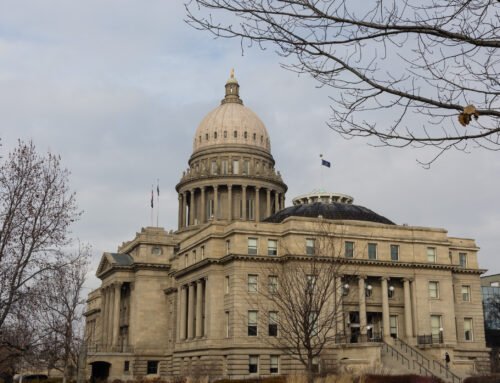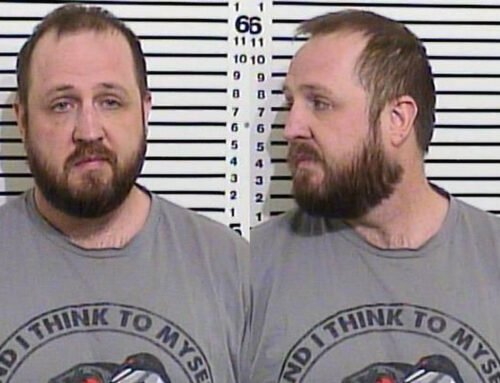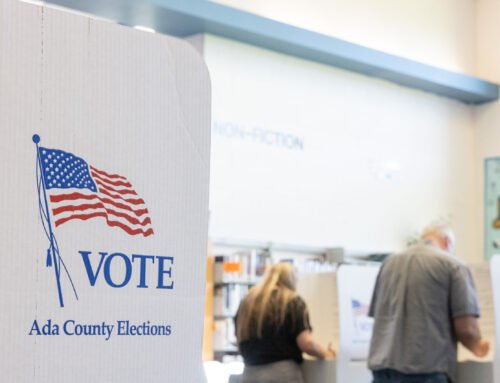IDAHO FALLS – For more than a century, the James Brady Memorial Chapel inside Pocatello’s Mountain View Cemetery has been an iconic historic landmark.
The city commemorated the building’s 100th anniversary last year. Efforts to update and restore it have been a work in progress since 2018.
The French Gothic Revival style building made of hand-carved limestone was dedicated on Memorial Day 1922 — the same day as the Lincoln Memorial in Washington, D.C., according to the city’s website. The non-denominational meditation chapel was originally the final resting place for its namesake’s ashes and was given to the city in 1959 by his widow, Irene Brady, and his sons from a previous marriage, S.E. Brady and J. Robb Brady.
At the time of his death in 1918, James Brady was one of the state’s most prominent citizens. Nick Nielson, president of the Friends of the Brady Chapel, the nonprofit raising funds for its restoration, describes Brady as a “charismatic, honest” man who was a “thorough business man.”
“He paid attention to details,” Nielson tells EastIdahoNews.com. “He was very dedicated to the state of Idaho and to the growth of Pocatello.”
Brady’s investments as a real estate broker brought him to the Gate City in 1895, where he became one of its biggest supporters. He advocated for its growth as a “large commercial center” and “one of the leading cities of the western slope.”
He became the Republican candidate for governor in 1908 and was elected to the Statehouse later that year. Two years after leaving office, he was appointed to fill a vacancy in the U.S. Senate, where he served until his death.
It’s these things that Nielson says make Brady a person worth remembering.
Brady’s road to the Statehouse
James Brady was born in Indiana County, Pennsylvania on June 12, 1862. His parents, John and Catherine, moved to Leavenworth, Kansas when he was 3 and that’s where Brady attended school.
Idaho’s future chief executive graduated from Leavenworth Normal College and eventually went on to study law. An article from the South Fork Companion reports Brady was likely an “intellectual prodigy.”
“Very young professionals, including lawyers, often fudged their age back then so as not to put off potential clients. It appears that’s what James did. When the 1880 U. S. Census recorder for Dickinson County, Kansas came round, James listed his age as 24, adding six years,” the blog says.
His law career didn’t last long, however. Brady worked as a newspaper editor in Enterprise, Kansas for a short time before eventually finding success in the real estate business.
After moving to Idaho, he became interested in water and irrigation projects. Irrigation canals were built throughout Bannock, Bingham and Fremont Counties under his direction, according to a life sketch provided by Nielson. That led to an interest in hydro-electric power and the development of a power plant along the Portneuf River in American Falls.
“There were three hydroelectric sites there, which was the precursor to Idaho Power & Light Co,” says Nielson.
The introduction of hydro-electricity is how Power County got its name when it was created in 1913, the South Fork Companion reports. These efforts laid the groundwork for the construction of the American Falls Dam in 1927.
RELATED | How Idaho’s 12th governor helped enhance one of the area’s primary water sources
It was around this same time that Brady got interested in politics. Nielson isn’t sure what sparked that, but says he may have looked at politics as a way to boost his business endeavors.
“He got to know a lot of people in the area when he was promoting his business,” Nielson explains.
Regardless of the reason, his involvement definitely boosted his popularity. An essay from former Boise State University Professor Glen Barrett in the book “Idaho’s Governors” says Brady served as vice president of the National Irrigation Congress for four years before becoming chairman of the Republican State Committee.
Brady beat his Democratic opponent Moses Alexander in the November 1908 election to become Idaho’s eighth governor. He had 47,864 votes, according to voting records, or 49.61% of the vote. Alexander had 41.61% of the vote.
Gubernatorial highlights
At the time, state and county officials were nominated through conventions. In his first address to the Idaho Legislature, Brady called for the passage of a direct primary law.
“The people should be permitted to express their preference for state and county officers,” Brady is reported to have said.
The law went into effect, and Brady’s successor, James Hawley, later said it was the “most important statute” passed during Brady’s first year in office.
A Republican victory wasn’t just happening in Idaho. William Howard Taft was elected president the same year and Nielson says Taft and Brady were good friends.
“That led to President Taft coming to Idaho once or twice,” Nielson says.
The 27th president paid a visit to Pocatello in 1911 to dedicate a viaduct over Center Street.
“President Taft weighed 325 pounds so a large auto was needed to accommodate him. Senator Brady had what they thought was just the machine … but they found out (it) was too big or the curve was too sharp so they abandoned the idea. They changed the program and met the President at the old Lander Street Crossing. They took him to breakfast at the Hotel Bannock,” Nielson writes in a PowerPoint presentation about Brady.

Brady’s final years
Though Brady won Idaho’s first primary election in 1910, the Democrats emerged victorious in the general election. James Hawley defeated Brady by about 900 votes, Barrett writes. He was sworn in as the Gem State’s ninth governor in Jan. 1911 and Brady returned to his business pursuits in and around Pocatello.
During this time, Brady was instrumental in getting Congress’ approval for a federal building in Pocatello on the north corner of Lewis and Arthur Streets. Construction got underway in 1916, Nielson says, and about $200,000 were allotted for the project.
When U.S. Senator Weldon Heyburn unexpectedly died in 1912, Brady was appointed to fill the vacancy. He was re-elected in 1914 but died with nearly a year left in his term.
Barrett reports Brady had returned to Washington, D.C. in January 1918 after a “busy vacation” in Pocatello. He apparently was in good health and had bought the Bannock Hotel during his trip. Ten days after his arrival, he had a heart attack at his home. He died three days later, on Jan. 13, 1918. He was 55.
After the funeral, Brady’s wife, and his two sons, moved back to Pocatello to manage his estate. They charged Pocatello architect Frank Paradice to design a memorial chapel that would bear his name. Construction lasted three years, the chapel’s website says.

Brady’s legacy
Brady’s widow passed away in 1959, 41 years after his death. The James Brady Memorial Chapel was listed on the state historical register in 1972. Today, the couple’s cremains are buried in the cemetery behind the chapel.
To date, more than $100,000 have been raised for restoration efforts on the chapel. The total cost of the project, which is happening in phases, is around $450,000. About $70,000 were provided through city funds. Grants will fund the rest of the cost, which Nielson and his team are working to acquire.
The type of work needed is listed on the chapel’s website. Nielson isn’t sure when the project will begin.
“We hope to start on phase 1 this spring. We don’t have a completion date because we don’t have all the funds available yet,” he says.
More than 100 years after Brady’s death, Nielson points to something Brady told the American Falls Press in Sept. 1912 that sums up his love for Pocatello and why he remains a beloved figure in the city’s history.
“I have always believed and still believe that Pocatello is destined to become a large commercial center and one of the leading cities of the western slope. I hope to be identified with its development,” Brady said.
RELATED LINKS
How a Malad banker became the second Latter-day Saint Democrat to serve as Idaho’s governor
How Idaho’s 12th governor helped enhance one of the area’s primary water sources
How a Rexburg man became the first Latter-day Saint to serve as Idaho’s governor
How a journalist from Arco became the first Idaho governor to serve nonconsecutive terms
Why Idaho’s 15th governor is deemed one of the Gem State’s ‘most fascinating political figures’
How a Missouri man founded an eastern Idaho town and became the Gem State’s 13th governor
The story of Idaho’s 18th governor and the political statement that denied him a second term
How an Idaho Falls Democrat became the state’s 16th governor and started a political dynasty
=htmlentities(get_the_title())?>%0D%0A%0D%0A=get_permalink()?>%0D%0A%0D%0A=htmlentities(‘For more stories like this one, be sure to visit https://www.eastidahonews.com/ for all of the latest news, community events and more.’)?>&subject=Check%20out%20this%20story%20from%20EastIdahoNews” class=”fa-stack jDialog”>






Leave A Comment